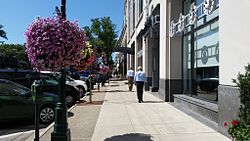Birmingham, Michigan
| Birmingham, Michigan | |
|---|---|
| City | |
| City of Birmingham | |
 |
|
| Motto: "A Walkable Community" | |
 Location of Birmingham, Michigan |
|
| Coordinates: 42°32′48″N 83°12′41″W / 42.54667°N 83.21139°WCoordinates: 42°32′48″N 83°12′41″W / 42.54667°N 83.21139°W | |
| Country | United States |
| State | Michigan |
| County | Oakland |
| Settled | 1819 |
| Incorporated | 1864 (village) |
| Incorporated | 1932 (city) |
| Government | |
| • Type | Council-Manager |
| • Mayor | Stuart Lee Sherman |
| • City Manager | Joseph A. Valentine |
| Area | |
| • City | 4.80 sq mi (12.43 km2) |
| • Land | 4.79 sq mi (12.41 km2) |
| • Water | 0.01 sq mi (0.03 km2) |
| Elevation | 778 ft (237 m) |
| Population (2010) | |
| • City | 20,103 |
| • Estimate (2012) | 20,437 |
| • Density | 4,196.9/sq mi (1,620.4/km2) |
| • Metro | 4,296,250 |
| Time zone | EST (UTC-5) |
| • Summer (DST) | EDT (UTC-4) |
| ZIP codes | 48009, 48012 |
| Area code(s) | 248 |
| FIPS code | 26-08640 |
| GNIS feature ID | 0621444 |
| Website | City of Birmingham, Michigan |
Birmingham is a city in Oakland County of the U.S. state of Michigan and a suburb of Detroit. As of the 2010 census, the population was 20,103.
The area comprising what is now the city of Birmingham was part of land ceded by Native American tribes to the United States government by the 1807 Treaty of Detroit. However, settlement was delayed first by the War of 1812 and subsequently by an unfavorable report by the Surveyor-General of the United States, Edward Tiffin, regarding the placement of Military Bounty Lands for veterans of the War of 1812. Tiffin's report claimed that "There would not be an acre out of a hundred, if there would be one out of a thousand that would, in any case, admit cultivation." In 1818, Territorial Governor Lewis Cass led a group of men along the Indian Trail. The governor's party discovered that the swamp was not as extensive as Tiffin had supposed. Not long after Cass issued a more encouraging report about the land, interest quickened in its suitability for settlement.
The earliest land entry was made on January 28, 1819, by Colonel Benjamin Kendrick Pierce (brother of future U.S. President Franklin Pierce) for the northwest quarter of section 36. Colonel Pierce visited his land several times, but never settled on it. In March 1818, John W. Hunter and his brother Daniel left Auburn, New York, by sleigh and traveled to Michigan by way of Upper Canada. They waited in Detroit for their father and other family members who arrived by schooner over Lake Erie in July. The family remained in Detroit until spring 1819 when John W. made an entry for the northeast quarter of section 36, now in the southeast section of current-day Birmingham. Lacking a proper land survey, John W. mistakenly built his log house on a tract later purchased by Elijah Willets. That house was later occupied by William Hall, a son-in-law of Elisha Hunter, while John W. Hunter built another log house a short distance to the southeast. On September 25, 1821, Elijah Willets made a land entry for the southwest quarter of section 25. Two days later, Major John Hamilton made an entry for the southeast quarter of section 25. Each of these initial land entries met at what is now the intersection of Maple Road and Pierce Street.
...
Wikipedia
